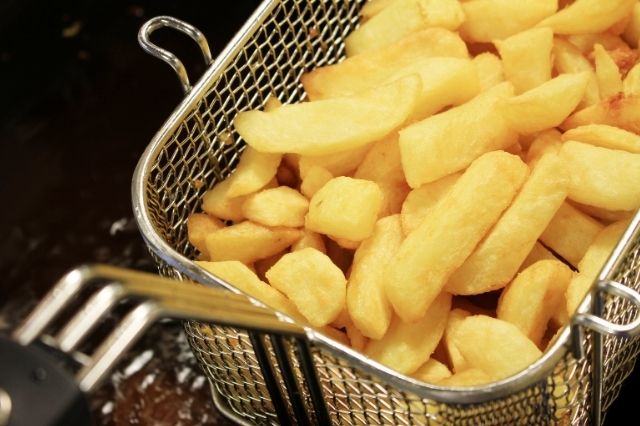Are you looking to find the right oil for your commercial kitchen?
Fried foods are really popular. That’s why most restaurants manage to add in at least a few of the fried favorites to their menu; and if you have a burger or fried chicken joint, most of your offerings are going to be fried.
All that frying requires the correct type of oil, because not every oil will be the best and most optimal oil for your commercial kitchen needs. After you pick your oil, it’s important to properly dispose of it, too.
In the following paragraphs, we at Grease Cycle will answer all the top questions about finding the perfect oil for your commercial deep fryer. Additionally, you’ll learn about the correct disposal of used oil.
What is the Best Oil for Deep Fryers?
Choosing the right oil for your deep frying needs is a crucial step. Picking the wrong oil can result in significantly lower quality of fried foods, which includes anything from fried chicken wings to french fries and onion rings.
Option #1: Canola Oil
One of the most common deep-frying oil picks is canola oil. This oil is expelled from the seeds of the rapeseed plant. Chefs love this oil because it doesn't overpower the taste and aroma of the food thanks to its neutral flavor profile.
Since canola oil has an average smoking point of 400 degrees Fahrenheit, it’s a good match for deep fryers. This oil offers stability as most of the commercial-grade deep fryers operate around 350 to 300 degrees Fahrenheit.
Canola oil is affordable compared to many other oils. Since canola oil is one of the cheapest frying oils on the market and it has a neutral flavor, it’s not hard to see why it has become a favorite for many commercial kitchen owners.
Option #2: Peanut Oil
When you compare the wholesale prices of peanut oil and canola oil, this nut oil tends to be a bit more expensive. However, it does have one important benefit: the smoking point of peanut oil is around 450 degrees.
If you have a deep fryer that operates at a temperature closer to 400 degrees, choosing peanut oil over canola oil makes perfect sense. The 50-degree difference provides an additional layer of oil stability when frying your foods.
The important thing to consider is the topic of peanut allergy. Many commercial kitchens avoid peanut oil because they are afraid of triggering peanut allergies.
Here’s the gist: purchasing only highly-refined peanut oil generally means that you're in the clear. If someone has a peanut allergy, it means that they are allergic to a specific type of protein in peanuts. Cold-pressed or less refined peanut oil could easily retain this protein, but that’s not the case with highly-refined peanut oil for deep-frying.
Another thing we need to address is the flavor profile of peanut oil. Many people believe that using peanut oil will give your food at least some peanut-y flavor. That’s not true! Peanut oil has a neutral flavor that's similar to canola oil.

What are the Factors to Consider When Choosing a Frying Oil?
While canola oil and peanut oil are prime picks for any restaurant kitchen, you may still want to do further research. There are plenty of other choices out there. Here are the top factors you should consider when evaluating your oil options:
Taste & Aroma
The process of deep frying means that your food is going to be submerged in the particular oil for some time. If you pick an oil with a strong flavor, it’s more likely that this will affect the taste of your menu items.
For instance, olive oil works great in salads, pasta dishes, and Italian-style pizzas, but that same flavor may not work if you use it to fry chicken nuggets or breaded cheese sticks.
Smoke Point
Always consider the smoke point of the oil. This term signifies the temperature point at which your oil starts breaking down. Reaching the breakdown temperature is accompanied by actual smoke rising from your deep fryer or pan.
Seeing any smoke means that your oil rapidly loses most of its nutritional value and its taste is severely affected. A typical deep fryer operates at a temperature range between 350 to 400 degrees Fahrenheit. That’s why oils with a smoking point of 400 degrees or higher work best.

How Do You Dispose of Used Oil?
Collect all your used frying oil instead of pouring it down the drain. It’s important because doing the latter will contribute to many issues.
Improper disposal of used commercial kitchen oil can threaten wildlife and our environment. Additionally, pouring your used frying oil down the drain considerably increases the risk of sewer blockages.
Make sure that you always collect your used frying oil in a grease trap. Regardless if you opt for canola oil, peanut oil, or something else, trapping the various fats, oils, and greases (collectively known as FOGs) is crucial.
Contact Greasecycle® to find a new purpose for your trapped frying oil. We are based in Raleigh, and our team collects cooking and frying oil from restaurants and other commercial kitchens from across North Carolina.
Working with us means that your used oil gets a second use! Most of our sourced oil is used as a feedstock for biodiesel production. That means the removed oil from your grease trap contributes to a more eco-friendly world.
In a Nutshell: Finding the Right Type of Oil for Your Restaurant
The frying and high-temperature cooking needs in your restaurant should be covered by proper oils. The best oils for deep frying include canola oil and peanut oil. You may find other oils that fit the bill, but make sure they have a neutral taste and a smoking point around or higher than 400 degrees Fahrenheit.
